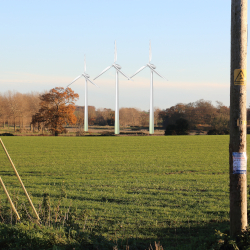
Most of us are aware that something odd is happening to our climate. The evidence now seems overwhelming this has something to do with human activity causing the release of greenhouse gasses into the atmosphere leading to a progressive rise in global temperatures. As temperatures increase, sea levels rise – of particular concern here in Norfolk – and weather becomes more chaotic.
The government is now reviewing the planning rules with a view to relaxing the restrictions limiting onshore wind farm development. Folk will put forward strong arguments both for and against onshore wind farm development but whatever your particular view, it is likely you will see more of those rotating fans in a neighbourhood near you in the coming years. For the new rules, it has been suggested that once again local residents will have a say but perhaps not the final say as before. There might also be benefits with local residents perhaps receiving a discount to their electricity bill.

There are some residents who might welcome large wind turbines near the village. There will be others who will not. But, before the latter group start manning the barricades there are a few things to ponder. First, the report is nearly 15 years old and views might since have changed. Sites for installation of wind turbines are less likely in shallow valleys where wind is less consistent. Impact on the value of the countryside and on the local environment will need to be taken into consideration. We are likely still a long way from seeing the giant fans marching across our fields, but if you don’t have a view, now is the time to start deciding where you stand.

Our representatives on the Burgh and Tuttington Parish Council have already been working on the topic of wind farms and they will likely keep a close eye on how new policies for onshore wind could affect us. No doubt, they will continue to express the views of local residents about wind farms to our district and county Councillors, to local planners, and to our MP.
So far, our Parish Councillors have concluded that offshore wind farms are preferred because they can be larger and cost-effective and wind is more consistent than onshore. Make sure you tell the Parish Council what you think.
(Editor’s Note: The siting of wind turbines suggested in this article is purely speculative and based upon a map published by the Greater Norwich Development Partnership in 2009. It represents the editorial view of the Tuttington Hub website only.)